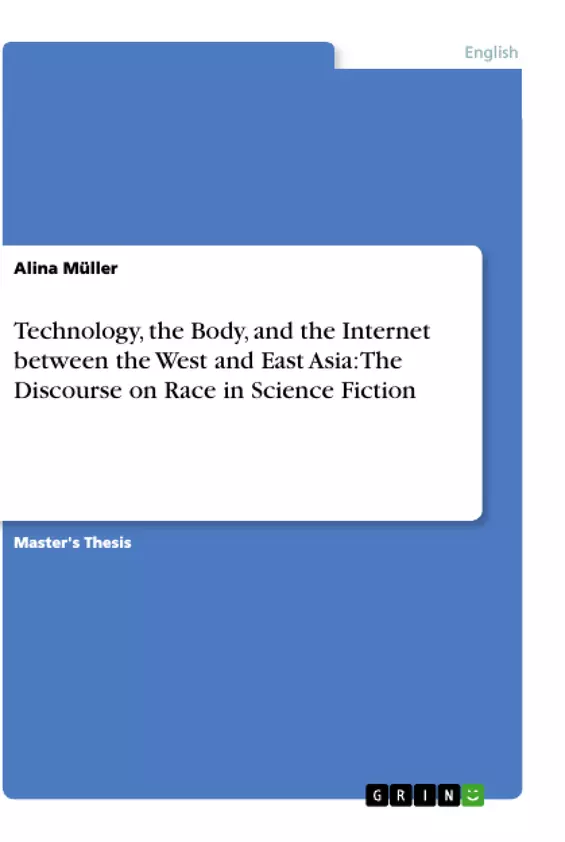The aim of this paper is to explore the intersection of the human body with technology and to demonstrate that cyborgs in fiction are often represented as the ethnic others and act as metaphors for experiences of ethnicity for whom social, cultural, economic or other forces matter. Gender and identity of fictitious cyborgs are the major points of analysis that will be explored within critical race theory, globalization and Asian American Studies. This paper also highlights that Neuromancer reveals the contrast between pre-technological imagery of powerless and vulnerable ethnic bodies in comparison to superior white bodies modified with new technology. Ghost in the Shell, in contrast, points to the technological power of the ethnic bodies that give them strength to liberate themselves from the white dominant discourse. Salt Fish Girl’s biopolitics emphasizes the biological power of the ethnic bodies offering alternative bodily possibilities beyond the technological and the artificial ones. This work also reveals that Neuromancer establishes clear distinctions between the dominant and subordinate, the technological and organic, the self and the other, whereas Ghost in the Shell and Salt Fish Girl blur these distinctions.
Besides, this paper also explores the impact of technology on a cyborg’s identity and subjectivity. As Alex Goody suggests: “any identity of a human being lies beyond its physical continuity” (153). In other words, cyborgs in fiction often speculate on possible outcomes of creating technological humans. The cyborgs are able to reveal hopes and anxieties concerning the fusion of technology and biology and to get into the conflict or disunity between their bodies, minds, and souls. The cyborgs are also often emotionally troubled by their memories that can be made prosthetic, false or be erased. This paper also reveals the ambiguous nature of technology because it can devalue and objectify the bodies or give them strength and empowerment. The concluding part of this paper reveals the role of East Asia in speculative fiction and the role of Internet technology for Asian American ethnicity and the representation of the cyborg body online. Cyberspace may also be associated with inaccurate representations of the ethnic bodies. The selected works limit the discussion of this paper to Chinese and Japanese people and culture in the West.
Inhaltsverzeichnis (Table of Contents)
- Introduction
- The Cyborg Body as a Metaphor for Ethnicity
- The Cyborg and His Master
- Hideo in Neuromancer
- The Puppet Master in Ghost in the Shell
- The Sonias in Salt Fish Girl
- The Gendered Cyborg
- Linda Lee in Neuromancer
- Motoko Kusanagi in Ghost in the Shell
- Miranda Ching in Salt Fish Girl
- The Cross-Ethnic Cyborg
- Molly Millions in Neuromancer
- Togusa in Ghost in the Shell
- Janitors in Salt Fish Girl
- Conclusion
Zielsetzung und Themenschwerpunkte (Objectives and Key Themes)
This paper examines the intersection of technology, the human body, and ethnicity in science fiction, focusing on the representation of Asian and Asian Americans as cyborgs. It aims to explore the ways in which cyborgs serve as metaphors for ethnic experiences, highlighting the impact of technology on identity and subjectivity.
- The portrayal of cyborgs as ethnic others
- The influence of technology on identity and subjectivity
- The role of critical race theory in analyzing ethnic representation in science fiction
- The impact of globalization and transnationalism on ethnic identity
- The interplay of technology, gender, and ethnicity in science fiction
Zusammenfassung der Kapitel (Chapter Summaries)
- Introduction: This chapter introduces the topic of technology and ethnicity in science fiction, focusing on the representation of Asian and Asian Americans as cyborgs. It highlights the significance of critical race theory in analyzing these representations and examines the fluidity of racial categories in contemporary society.
- The Cyborg Body as a Metaphor for Ethnicity: This chapter explores the use of the cyborg body as a metaphor for ethnicity in science fiction. It discusses the ways in which cyborgs can represent the experiences of marginalization and otherness that are often faced by ethnic minorities.
- The Cyborg and His Master: This chapter examines specific characters from the selected texts, analyzing their roles as cyborgs and exploring the power dynamics that exist between them. It looks at how these characters embody the complexities of race, gender, and technology in science fiction.
- The Gendered Cyborg: This chapter focuses on the gendered aspects of cyborg representation, analyzing the ways in which female and male cyborgs are portrayed in the selected texts. It discusses the interplay of gender and ethnicity in these representations, highlighting the challenges faced by ethnic women in a technologically advanced society.
- The Cross-Ethnic Cyborg: This chapter examines the representation of cross-ethnic cyborgs, focusing on characters who embody a mix of ethnicities and cultures. It explores the implications of this representation for understanding ethnic identity in a globalized world.
Schlüsselwörter (Keywords)
This paper focuses on the intersection of technology, the body, and ethnicity in science fiction, exploring the representation of Asian and Asian Americans as cyborgs. Key themes include critical race theory, globalization, transnationalism, identity formation, and the impact of technology on subjectivity. Specific terms like cyberpunk, biopolitics, and ethnic diasporic experiences are also crucial to understanding the complexities of the subject matter.
- Citation du texte
- Alina Müller (Auteur), 2016, Technology, the Body, and the Internet between the West and East Asia: The Discourse on Race in Science Fiction, Munich, GRIN Verlag, https://www.grin.com/document/1133572



